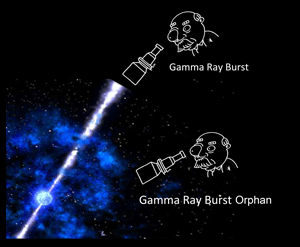Square Kilometre Array will see sky bubbling with exploding stars

It is hard to imagine that any astronomical phenomenon could escape our latest and most powerful telescopes, but an international research team has now forecast some of the exotic discoveries that will only be able to be studied with the forthcoming Square Kilometre Array (SKA).
The team, led by Dr Giancarlo Ghirlanda at the National Institute for Astrophysics in Italy and including CAASTRO members Dr Davide Burlon and Dr Tara Murphy from the University of Sydney, has calculated that the SKA will reveal the lingering footprints of tens of thousands of enigmatic cosmic explosions known as "gamma-ray bursts".
"With current telescopes, we see a bright gamma-ray burst somewhere in the Universe around once per day, but new radio telescopes will soon be able to see an afterglow of the explosion after the initial burst has faded away," explains CAASTRO postdoctoral researcher Dr Burlon.
"This afterglow can generally take weeks to gradually decay and teaches us incredible amounts about both the initial explosion and its neighbourhood."
The catch is that a gamma-ray burst is not an explosion that we can see from all directions but is comprised of a very narrow, energetic jet, so we need to be looking down the barrel of the jet at the right time. Otherwise it is invisible, equivalent to only seeing the beam of a laser pointer when it points directly at us.
The radio afterglow should be visible from any direction though and for long periods of time, even if we missed the burst. These afterglows without a burst are known as "orphan" afterglows – they're a phenomenon that astronomers have until now been looking for without success.
"From the rate at which we detect gamma-ray bursts, we were able to predict that with the power of a sensitive new telescope like the SKA, orphan afterglows should be seen 700 times more often than their gamma-ray bursts." says Dr Burlon.
"The unprecedented sensitivity and wide field-of view of the SKA means that orphan afterglows should be visible for months or even years before eventually disappearing – bubbling across the sky more than ten thousand times per year."
Of course, the SKA's view of the sky will be full of all sorts of objects and events, such as supernova explosions and flaring black holes that are more common than orphan afterglows.
"In this new era of radio astronomy, one of the challenges will be to disentangle these different classes of radio sources." says Dr Tara Murphy, CAASTRO Associate Investigator and project leader of the "Variables and Slow Transients" survey with the Australian SKA Pathfinder (ASKAP).
The SKA will join the Australian SKA precursor telescope ASKAP and the South African SKA precursor MeerKAT in painting an entirely new picture of the "radio sky".
"The SKA will not only allow us to finally see these orphan afterglows but help us understand how gamma-ray bursts produce such powerful, narrow jets and will cast new light on the big question of just what causes gamma-ray bursts in the first place," concludes Dr Ghirlanda.
More information: G. Ghirlanda, D. Burlon, G. Ghisellini, R. Salvaterra, M. G. Bernardini, S. Campana, S. Covino, P. D'Avanzo, V. D'Elia, A. Melandri, T. Murphy, L. Nava, S. D. Vergani, G. Tagliaferri: "GRB orphan afterglows in present and future radio transient surveys" in The Publications of the Astronomical Society of Australia (PASA). arXiv:1402.6338 [astro-ph.HE] arxiv.org/abs/1402.6338
Provided by CAASTRO




















